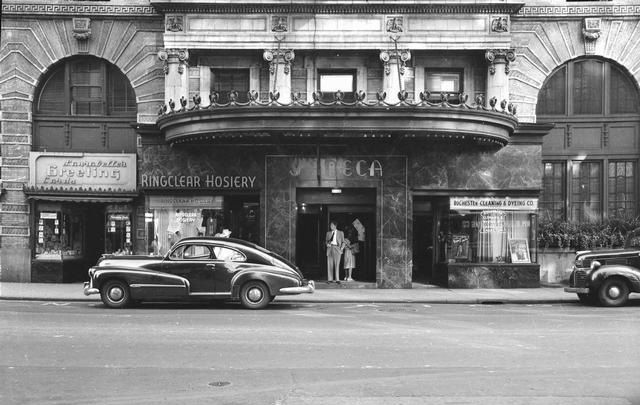This article was scraped from Rochester Subway. This is a blog about Rochester history and urbanism has not been published since 2017. The current owners are now publishing link spam which made me want to preserve this history.. The original article was published September 14, 2012 and can be found here.
![The Seneca Hotel, 26 S. Clinton Avenue, south of E. Main Street on the east side of the street. The stores in front, left to right, are Laurabelle's Greeting Cards, Ringclear Hosery Co., and Rochester Cleaning & Dyeing Co. [PHOTO: Rochester Municiple Archives]](https://senseofplace.dev/content/images/photos/rochester-seneca-hotel-front.jpg)
On September 14, 1908 a new 300 room hotel with ballroom, several dining rooms and meeting rooms opened its doors - right smack on the same spot where Windstream (Paetec) is constructing its new building today.
The following article was published in the New York Times on Monday September 14, 1908...
ROCHESTER'S NEW HOTEL The Seneca, a Beautiful and
Modern Hostelry, Opens To-day.
![The Hotel Seneca opened in 1908 with 300 rooms, a ballroom, several dining and meeting rooms. [IMAGE: Vintage Postcard, Rochester Public Library]](https://senseofplace.dev/content/images/photos/rochester-seneca-hotel-1.jpg)
ROCHESTER, Sept. 13 -- Rochester's new hotel, the Seneca, will be opened tomorrow in time for the State Democratic Convention, which meets here Tuesday. The hostelry in size will compare with the Hotel Astor in New York

. Its architecture is in a general way French Renaissance. It is constructed of brick of brownish hue, trimmed with gray terra-cotta. The hotel has a frontage of 130 feet on Clinton Avenue, and is only a couple of blocks from the city's Convention Hall. It runs back 200 feet to Cortland Street, and along the side has the advantage of a private roadway 30 feet wide. The main entrance to the lobby of the hotel is from this private street. This provides a porte cochere, which affords protection to those alighting from carriages in inclement weather.
![The main lobby of the Seneca Hotel. [IMAGE: Vintage Postcard, Rochester Public Library]](https://senseofplace.dev/content/images/photos/rochester-seneca-hotel-lobby.jpg)
The decoration of the spacious lobby follows the Renaissance style, with wainscoting of French marble, wall panels of greenish brown, ivory columns with Oriental caps in dull old gold, and ceilings suggestive of old illuminated Spanish leather book covers. Cornices and brackets are in old gold. Throughout the entire ground floor, in the various dining rooms and buffets, elaborate and rich decorative schemes are carried out.
![The Ladies Dining Room. [IMAGE: Vintage Postcard, Rochester Public Library]](https://senseofplace.dev/content/images/photos/rochester-seneca-hotel-ladies-dining-room.jpg)
The mezzanine floor of the hotel contains about one-half as much space as the hotel covers. The ballroom, on the second floor, which will also be utilized as a banquet room and convention hall, will seat from 700 to 1,000. The management of the Seneca is in the hands of H.M. Gerrans and E.T. Osborn, hotel men of New York, Buffalo, and Detroit.
By the early 1920s a 10-story addition would be added to the Seneca (shown below), making it Rochester's largest hotel with over 500 rooms. By comparison, today's largest hotel--Riverside Radisson--is only 460 rooms.
![By the early 1920s a 10-story addition was added, making the Seneca Rochester's largest hotel with over 500 rooms. [IMAGE: Vintage Postcard, Rochester Public Library]](https://senseofplace.dev/content/images/photos/rochester-seneca-hotel-2.jpg)
According to a menu from the hotel's Crystal Dining Room, one could enjoy a filet mignon for $1.89. Holy inflation!
![The Seneca Hotel (right) on Clinton Avenue with the Temple and Lyceum Theatres in the foreground. [PHOTO: Albert R. Stone Collection]](https://senseofplace.dev/content/images/photos/rochester-clinton-avenue-1926.jpg)
An out-of-towner looking for stuff to do while staying at the Seneca would find no shortage of shopping and entertainment in this neighborhood. They had Sibley's, B. Foreman Co., and McCurdy's department stores. There was the Century, Temple and Lyceum Theatres. There was even a Wegmans. All within one square block! Or jump on a streetcar and the entire city was at your fingertips.
![The Seneca Hotel near Main & Clinton, 1935. Lots of shopping and entertainment in this little neighborhood. [SOURCE: Rochester Public Library]](https://senseofplace.dev/content/images/photos/rochester-clinton-ave-1935-map.jpg)
Compare all that there was to do in 1935 (above) with the giant office complexes that are here now...
![The Midtown Plaza crater. Former site of Seneca Hotel. [PHOTO: Google Maps]](https://senseofplace.dev/content/images/photos/rochester-clinton-ave-satellite-map.jpg)
And we wonder why no one comes downtown anymore?
![Delegates to the New York State Republican convention gather in the lobby of the Seneca Hotel. Posters show support for various candidates for nomination. c.1924 [PHOTO: Albert R. Stone Collection]](https://senseofplace.dev/content/images/photos/rochester-seneca-hotel-republican-convention.jpg)
This was the meeting place of choice for New York's power brokers. Shown above, delegates to the 1924 New York State Republican convention gather in the lobby of the Seneca Hotel. Posters show support for various candidates for nomination. Some of the more visible posters read, "We can win with Judge Tompkins for Governor", "Guy B. Moore for Governor", "For Secretary of State, Charles W. Taft", "Bill Hayward's Headquarters".
![Albert Stone, photographer for the Rochester Herald newspaper, sits on a plank as Hotel Seneca is being constructed. c.1907 [PHOTO: Albert R. Stone Collection]](https://senseofplace.dev/content/images/photos/albert-stone-seneca-hotel)
Many of the photographs on RochesterSubway.com were taken by this man (above). Albert Stone, photographer for the Rochester Herald newspaper, sits on a plank as Hotel Seneca is being constructed. He's 130 feet above the intersection of South Clinton Avenue and Main Street looking through a camera at the street below.
![Manger Hotel's Hearth and Embers restaurant shortly before the building was demolished. [PHOTO: Rochester Public Library]](https://senseofplace.dev/content/images/photos/manger-hotel-hearth-and-embers-restaurant.jpg)
In 1957, the Seneca became the Manger Hotel. The image above is the Manger Hotel's "Hearth and Embers" restaurant taken shortly before the hotel closed for good. In 1969 it was razed to make way for Midtown Plaza.


